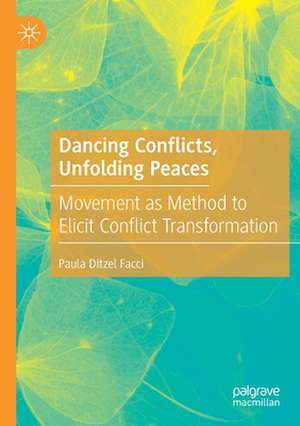Dancing Conflicts, Unfolding Peaces: Movement as Method to Elicit Conflict Transformation
Autor Paula Ditzel Faccien Limba Engleză Paperback – 15 aug 2021
| Toate formatele și edițiile | Preț | Express |
|---|---|---|
| Paperback (1) | 387.20 lei 6-8 săpt. | |
| Springer International Publishing – 15 aug 2021 | 387.20 lei 6-8 săpt. | |
| Hardback (1) | 391.99 lei 6-8 săpt. | |
| Springer International Publishing – 14 aug 2020 | 391.99 lei 6-8 săpt. |
Preț: 387.20 lei
Nou
Puncte Express: 581
Preț estimativ în valută:
74.10€ • 77.08$ • 61.17£
74.10€ • 77.08$ • 61.17£
Carte tipărită la comandă
Livrare economică 15-29 aprilie
Preluare comenzi: 021 569.72.76
Specificații
ISBN-13: 9783030488406
ISBN-10: 3030488403
Pagini: 280
Ilustrații: XVII, 280 p. 1 illus.
Dimensiuni: 148 x 210 mm
Greutate: 0.4 kg
Ediția:1st ed. 2020
Editura: Springer International Publishing
Colecția Palgrave Macmillan
Locul publicării:Cham, Switzerland
ISBN-10: 3030488403
Pagini: 280
Ilustrații: XVII, 280 p. 1 illus.
Dimensiuni: 148 x 210 mm
Greutate: 0.4 kg
Ediția:1st ed. 2020
Editura: Springer International Publishing
Colecția Palgrave Macmillan
Locul publicării:Cham, Switzerland
Cuprins
Chapter 1: Introduction: Warming Up.- Chapter 2: Unfolding Peace: Many Peaces, Dances and The Search for Balance.- Chapter 3: Conflicts: Upholding Opposites in Creative Tension.- Chapter 4: Dancing Conflicts: Movement as a Method to Elicit Conflict Transformation.- Chapter 5: Conclusion: Invitation to Continue the Dance.
Notă biografică
Paula Ditzel Facci is a Lecturer at the Unit for Peace and Conflict Studies, University of Innsbruck, Austria, and at the Instituto Paz e Mente, Brazil. She has been a Visiting Research Fellow at the Kroc Institute for International Peace Studies.
Textul de pe ultima copertă
“In this illuminating book, peace is a presence – embodied and relational – and dance is a path to finding it. By pairing Gabrielle Roth’s 5Rhythms movement practice with theories of Conflict Transformation, Ditzel Facci unfolds a promising approach to resolving conflicts at multiple levels that mobilizes the sensory awareness of bodily selves as a potent resource for discovering paths through pain to peace.”
— Kimerer L. LaMothe, PhD. Author of Why We Dance, USA
This book explores the potential of movement as a means of eliciting conflict transformation and unfolding peace at the intrapersonal and relational levels. It examines how peace and dance have been related in different cultures and investigates embodied ways to creatively tap the energies of conflicts, inspiring possibilities of transformation and new dynamics in relationships. Drawing on Wolfgang Dietrich’s Many Peaces theory, the book discusses how different expressions of dance have been connected to different interpretations of peace and strategies for transformation. Delving into elicitive approaches to conflict transformation, the book develops an innovative framework for applying movement as an elicitive method, which it vividly presents through the author’s own experiences and interviews with participants in workshops. Given its scope, the book will appeal to scholars, practitioners and artists working at the nexus of peace, conflict transformation and the arts.
— Kimerer L. LaMothe, PhD. Author of Why We Dance, USA
“During this time of ecosystem collapse, when the earth is reminding humanity that a reductionist, disembodied approach to living is unsustainable, Dancing Conflicts, Unfolding Peaces puts forth a hope that humanity can reintegrate mind and body. The antidote to polarization lies in remembering we are all part of an interconnected, living web.”
— David Diamond, Author of Theatre for Living: the art and science of community-based dialogue, Canada
— David Diamond, Author of Theatre for Living: the art and science of community-based dialogue, Canada
“In times of fruitful dialogue between different knowledges, facing the author’s invitation is challenging: stripping bodies and souls of all affectation and camouflage to recognize themselves in their vulnerability and fear of nonacceptance. The fluidity of the movement that translates into dance eases concepts and prejudices that seek to affirm truths, and in this embrace, both are transformed.”
— Lia Diskin, Co-Founder Palas Athena Association, Brazil
— Lia Diskin, Co-Founder Palas Athena Association, Brazil
Caracteristici
Discusses how different expressions of dance have been connected to different interpretations of peace and strategies for transformation Develops an innovative theoretical and practical framework for applying movement as an elicitive method Will appeal to scholars, peacebuilders, practitioners, and artists working at the nexus of peace, conflict transformation and the arts
